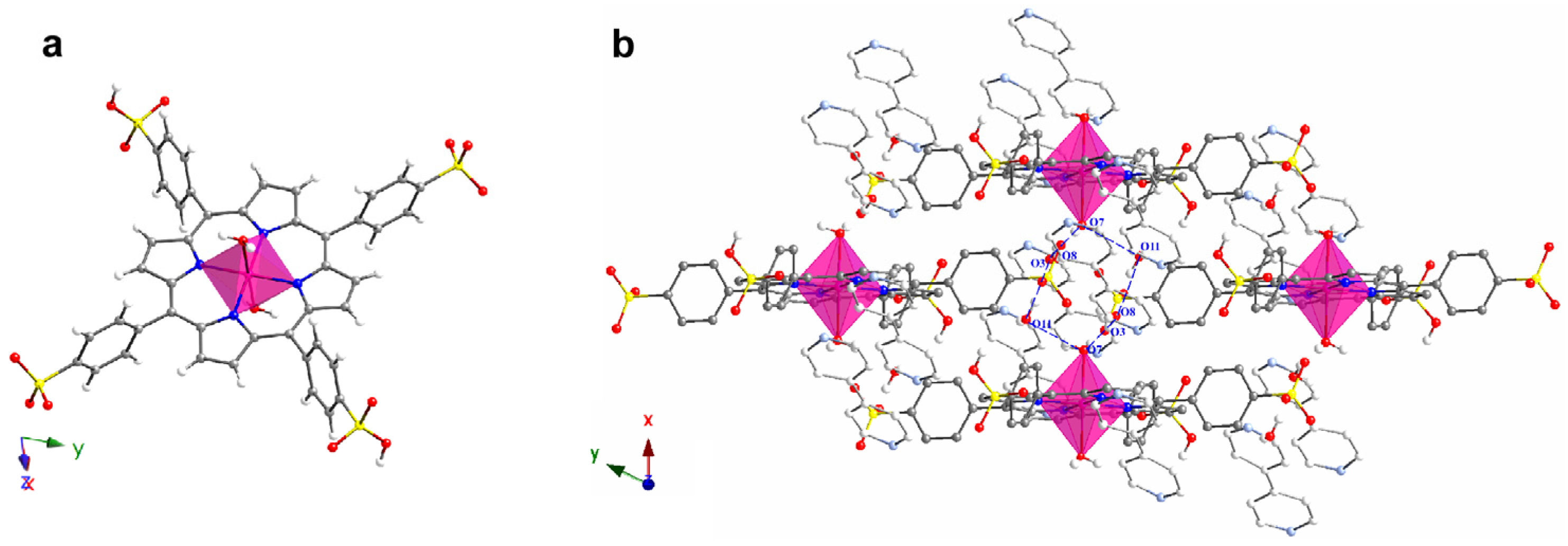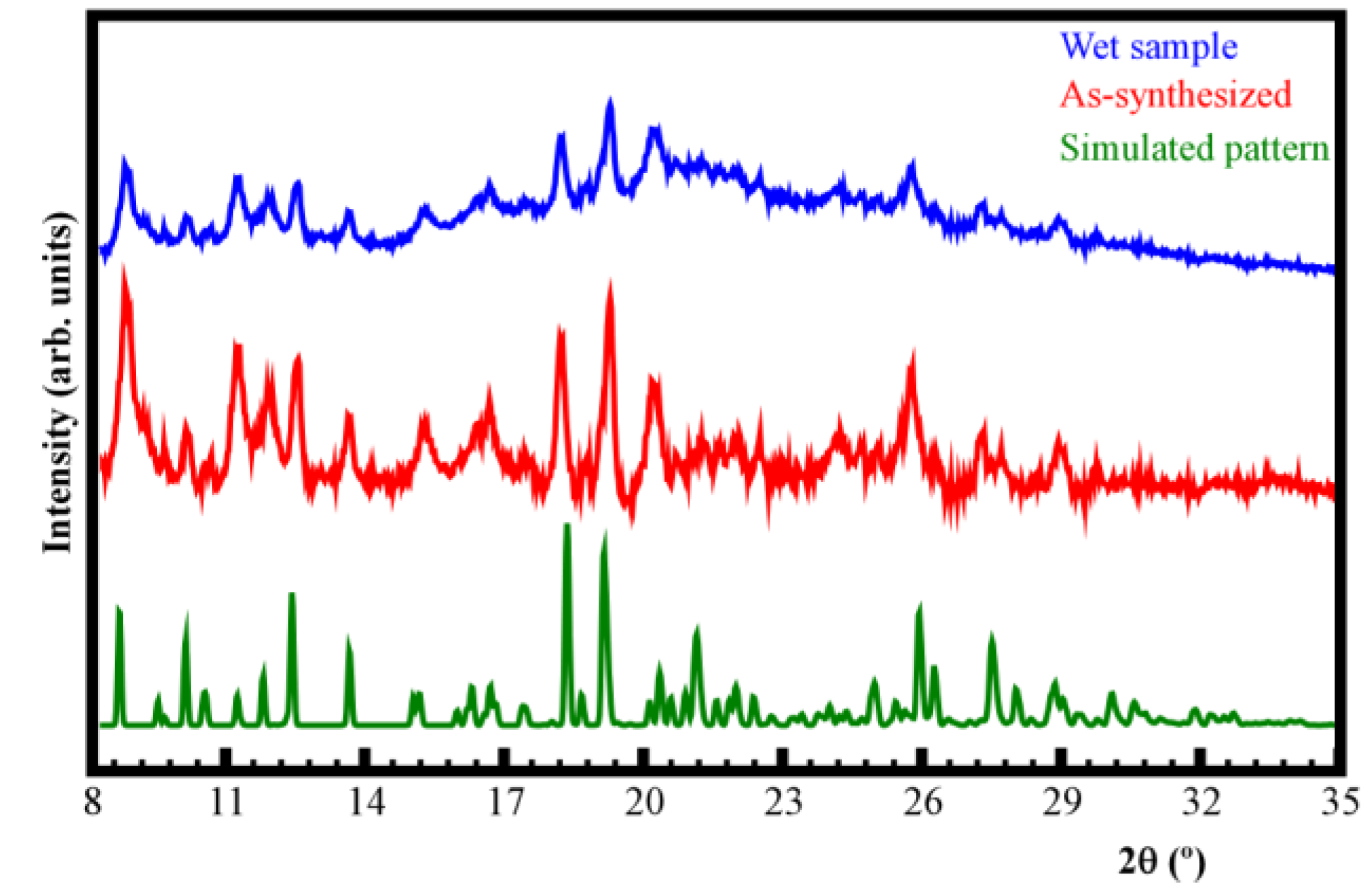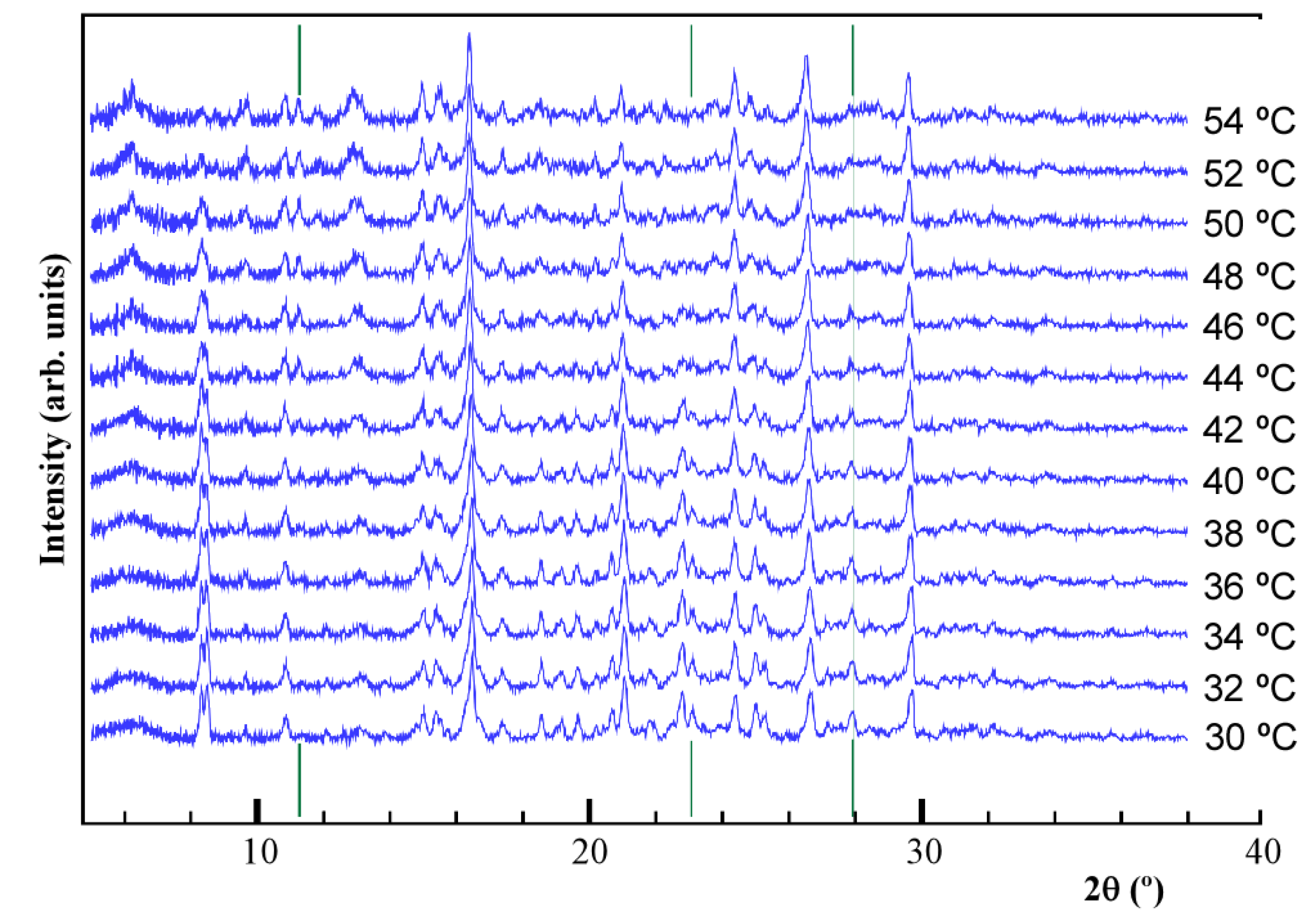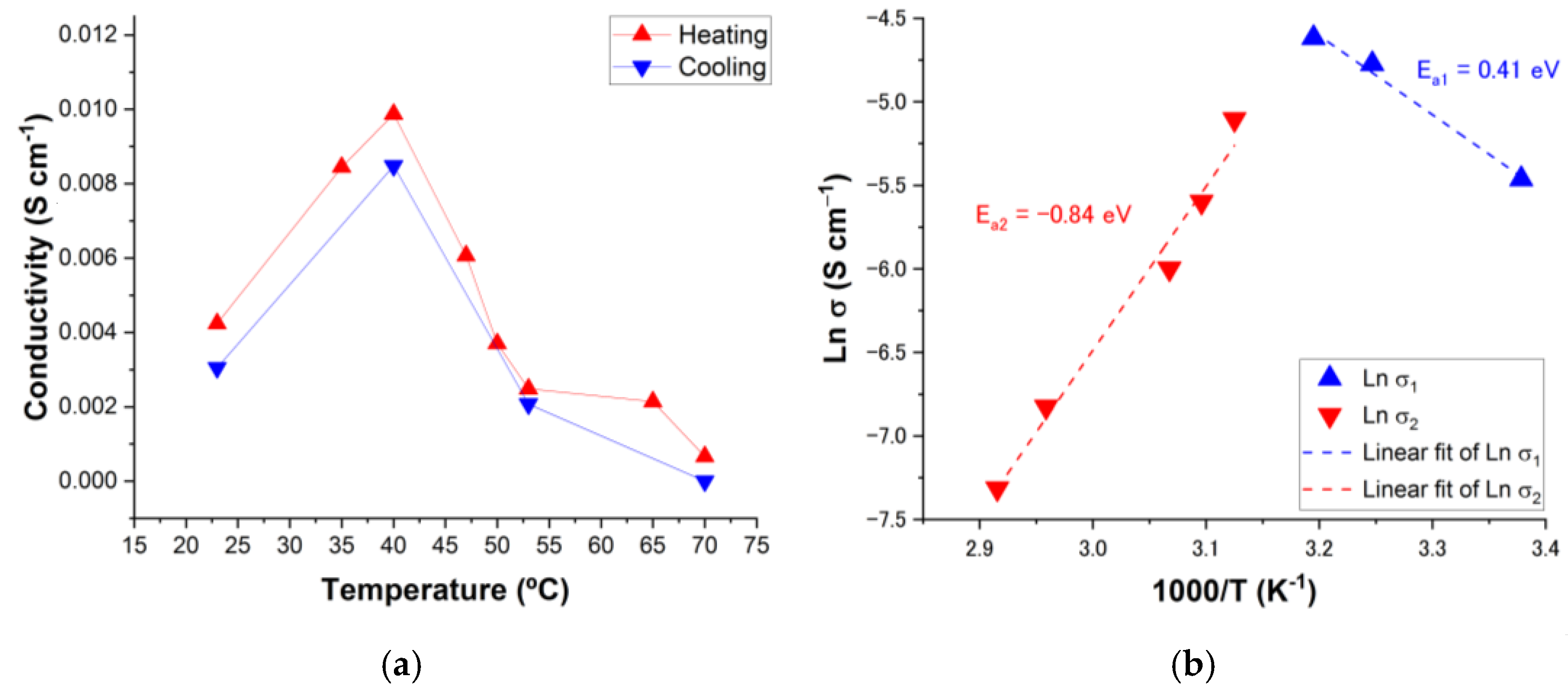Superprotonic Conductivity in a Metalloporphyrin-Based SMOF (Supramolecular Metal–Organic Framework)
Abstract
:1. Introduction
2. Materials and Methods
3. Results and Discussion
3.1. Synthesis and Crystal Structure
3.2. Thermal Analysis
3.3. Proton Conductivity
4. Conclusions
Author Contributions
Funding
Data Availability Statement
Acknowledgments
Conflicts of Interest
References
- Weinberg, D.R.; Gagliardi, C.J.; Hull, J.F.; Murphy, C.F.; Kent, C.A.; Westlake, B.C.; Paul, A.; Ess, D.H.; McCafferty, D.G.; Meyer, T.J. Proton-Coupled Electron Transfer. Chem. Rev. 2012, 112, 4016–4093. [Google Scholar] [CrossRef]
- Jiang, J.C.; Yaghi, O.M. Bronsted Acidity in Metal-Organic Frameworks. Chem. Rev. 2015, 115, 6966–6997. [Google Scholar] [CrossRef]
- Takaoka, T.; Sakashita, N.; Saito, K.; Ishikita, H. pK(a) of a Proton-Conducting Water Chain in Photosystem II. J. Phys. Chem. Lett. 2016, 7, 1925–1932. [Google Scholar] [CrossRef] [PubMed]
- Li, A.L.; Gao, Q.; Xu, J.; Bu, X.H. Proton-conductive metal-organic frameworks: Recent advances and perspectives. Coord. Chem. Rev. 2017, 344, 54–82. [Google Scholar] [CrossRef]
- Malmstrom, B.G. Cytochrome oxidase: Pathways for electron tunneling and proton transfer. J. Biol. Inorg. Chem. 1998, 3, 339–343. [Google Scholar] [CrossRef]
- Enguita, F.J.; Pohl, E.; Turner, D.L.; Santos, H.; Carrondo, M.A. Structural evidence for a proton transfer pathway coupled with haem reduction of cytochrome c″ from Methylophilus methylotrophus. J. Biol. Inorg. Chem. 2006, 11, 189–196. [Google Scholar] [CrossRef] [PubMed]
- Casadio, R.; Melandri, B.A. CaATP inhibition of the MgATP-dependent proton pump (H+-ATPase) in bacterial photosynthetic membranes with a mechanism of alternative substrate inhibition. J. Biol. Inorg. Chem. 1996, 1, 284–291. [Google Scholar] [CrossRef]
- Williams, R.J.P. Proton circuits in biological energy interconversions. Annu. Rev. Biophys. Biophys. Chem. 1988, 17, 71–97. [Google Scholar] [CrossRef]
- Nagle, J.F.; Tristramnagle, S. Hydrogen-bonded chain mechanisms for proton conduction and proton pumping. J. Membr. Biol. 1983, 74, 1–14. [Google Scholar] [CrossRef]
- Wikstrom, M.; Verkhovsky, M.I.; Hummer, G. Water-gated mechanism of proton translocation by cytochrome c oxidase. Biochim. Biophys. Acta-Bioenerg. 2003, 1604, 61–65. [Google Scholar] [CrossRef]
- Kreuer, K.D. Proton conductivity: Materials and applications. Chem. Mater. 1996, 8, 610–641. [Google Scholar] [CrossRef]
- Yoon, M.; Suh, K.; Natarajan, S.; Kim, K. Proton Conduction in metal-organic frameworks and related modularly built porous solids. Angew. Chem.-Int. Ed. 2013, 52, 2688–2700. [Google Scholar] [CrossRef] [PubMed]
- Fabbri, E.; Pergolesi, D.; Traversa, E. Materials challenges toward proton-conducting oxide fuel cells: A critical review. Chem. Soc. Rev. 2010, 39, 4355–4369. [Google Scholar] [CrossRef] [PubMed]
- Norby, T. Proton conduction in solids: Bulk and interfaces. MRS Bull. 2009, 34, 923–928. [Google Scholar] [CrossRef]
- Sun, S.C.; Tang, Q.M.; Zhang, K.K.; Wen, Y.T.; Billings, A.; Huang, K. A focused review on structures and ionic conduction mechanisms in inorganic solid-state proton and hydride anion conductors. Mater. Adv. 2023, 4, 389–407. [Google Scholar] [CrossRef]
- Lim, D.W.; Sadakiyo, M.; Kitagawa, H. Proton transfer in hydrogen-bonded degenerate systems of water and ammonia in metal-organic frameworks. Chem. Sci. 2019, 10, 16–33. [Google Scholar] [CrossRef] [PubMed]
- Sharma, A.; Lim, J.; Lah, M.S. Strategies for designing metal-organic frameworks with superprotonic conductivity. Coord. Chem. Rev. 2023, 479, 214995. [Google Scholar] [CrossRef]
- Taylor, J.M.; Dawson, K.W.; Shimizu, G.K.H. A water-stable metal-organic framework with highly acidic pores for proton-conducting applications. J. Am. Chem. Soc. 2013, 135, 1193–1196. [Google Scholar] [CrossRef]
- Lim, D.W.; Kitagawa, H. Proton Transport in metal-organic frameworks. Chem. Rev. 2020, 120, 8416–8467. [Google Scholar] [CrossRef]
- Xiang, F.H.; Chen, S.M.; Yuan, Z.; Li, L.; Fan, Z.W.; Yao, Z.Z.; Liu, C.L.; Xiang, S.C.; Zhang, Z.J. Switched proton conduction in metal-organic frameworks. J. Am. Chem. Soc. 2022, 2, 1043–1053. [Google Scholar] [CrossRef]
- Kanda, S.; Yamashita, K.; Ohkawa, K. Proton conductive coordination polymer. I. [N,N′-bis(2-hydroxyethyl)dithiooxamido] copper(II). Bull. Chem. Soc. Jpn. 1979, 52, 3296–3301. [Google Scholar] [CrossRef]
- Nagao, Y.; Fujishima, M.; Ikeda, R.; Kanda, S.; Kitagawa, H. Highly proton-conductive copper coordination polymers. Synth. Met. 2003, 133, 431–432. [Google Scholar] [CrossRef]
- Nagao, Y.; Kubo, T.; Nakasuji, K.; Ikeda, R.; Kojima, T.; Kitagawa, H. Preparation and proton transport property of N,N′-diethyldithiooxamidatocopper coordination polymer. Synth. Met. 2005, 154, 89–92. [Google Scholar] [CrossRef]
- Sadakiyo, M.; Yamada, T.; Kitagawa, H. Hydrated proton-conductive metal-organic frameworks. ChemPlusChem 2016, 81, 691–701. [Google Scholar] [CrossRef] [PubMed]
- Yamada, T.; Sadakiyo, M.; Shigematsu, A.; Kitagawa, H. Proton-conductive metal-organic frameworks. Bull. Chem. Soc. Jpn. 2016, 89, 1–10. [Google Scholar] [CrossRef]
- Wang, C.H.; Liu, X.L.; Demir, N.K.; Chen, J.P.; Li, K. Applications of water stable metal-organic frameworks. Chem. Soc. Rev. 2016, 45, 5107–5134. [Google Scholar] [CrossRef]
- Ramaswamy, P.; Wong, N.E.; Shimizu, G.K.H. MOFs as proton conductors—Challenges and opportunities. Chem. Soc. Rev. 2014, 43, 5913–5932. [Google Scholar] [CrossRef]
- Escobar-Hernandez, H.U.; Perez, L.M.; Hu, P.F.; Soto, F.A.; Papadaki, M.I.; Zhou, H.C.; Wang, Q.S. Thermal stability of metal-organic frameworks (MOFs): Concept, determination, and model prediction using computational chemistry and machine learning. Ind. Eng. Chem. Res. 2022, 61, 5853–5862. [Google Scholar] [CrossRef]
- Yamada, T.; Otsubo, K.; Makiura, R.; Kitagawa, H. Designer coordination polymers: Dimensional crossover architectures and proton conduction. Chem. Soc. Rev. 2013, 42, 6655–6669. [Google Scholar] [CrossRef]
- Tu, T.N.; Phan, N.Q.; Vu, T.T.; Nguyen, H.L.; Cordova, K.E.; Furukawa, H. High proton conductivity at low relative humidity in an anionic Fe-based metal-organic framework. J. Mater. Chem. A 2016, 4, 3638–3641. [Google Scholar] [CrossRef]
- Yang, F.; Huang, H.L.; Wang, X.Y.; Li, F.; Gong, Y.H.; Zhong, C.L.; Li, J.R. Proton Conductivities in functionalized UiO-66: Tuned properties, thermogravimetry mass, and molecular simulation analyses. Cryst. Growth Des. 2015, 15, 5827–5833. [Google Scholar] [CrossRef]
- Ramaswamy, P.; Wong, N.E.; Gelfand, B.S.; Shimizu, G.K.H. A water stable magnesium MOF that conducts protons over 10−2 S cm−1. J. Am. Chem. Soc. 2015, 137, 7640–7643. [Google Scholar] [CrossRef]
- Nguyen, N.T.T.; Furukawa, H.; Gandara, F.; Trickett, C.A.; Jeong, H.M.; Cordova, K.E.; Yaghi, O.M. Three-dimensional metal-catecholate frameworks and their ultrahigh proton conductivity. J. Am. Chem. Soc. 2015, 137, 15394–15397. [Google Scholar] [CrossRef]
- Mauritz, K.A.; Moore, R.B. State of understanding of Nafion. Chem. Rev. 2004, 104, 4535–4585. [Google Scholar] [CrossRef]
- Kim, H.J.; Talukdar, K.; Choi, S.-J. Tuning of Nafion by HKUST-1 as coordination network to enhance proton conductivity for fuel cell applications. J. Nanoparticle Res. 2016, 18, 47. [Google Scholar] [CrossRef]
- Rolandi, M. Bioelectronics: A positive future for squid proteins. Nat. Chem. 2014, 6, 563–564. [Google Scholar] [CrossRef] [PubMed]
- Pena-Francesch, A.; Jung, H.; Hickner, M.A.; Tyagi, M.; Allen, B.D.; Demirel, M.C. Programmable Proton conduction in stretchable and self-healing proteins. Chem. Mater. 2018, 30, 898–905. [Google Scholar] [CrossRef]
- Ordinario, D.D.; Phan, L.; Walkup, W.G.; Jocson, J.M.; Karshalev, E.; Husken, N.; Gorodetsky, A.A. Bulk protonic conductivity in a cephalopod structural protein. Nat. Chem. 2014, 6, 597–603. [Google Scholar] [CrossRef] [PubMed]
- Wunsche, J.; Deng, Y.X.; Kumar, P.; Di Mauro, E.; Josberger, E.; Sayago, J.; Pezzella, A.; Soavi, F.; Cicoira, F.; Rolandi, M.; et al. Protonic and electronic transport in hydrated thin films of the pigment eumelanin. Chem. Mater. 2015, 27, 436–442. [Google Scholar] [CrossRef]
- Almeida-Marrero, V.; van de Winckel, E.; Anaya-Plaza, E.; Torres, T.; de la Escosura, A. Porphyrinoid biohybrid materials as an emerging toolbox for biomedical light management. Chem. Soc. Rev. 2018, 47, 7369–7400. [Google Scholar] [CrossRef] [PubMed]
- Biesaga, M.; Pyrzynska, K.; Trojanowicz, M. Porphyrins in analytical chemistry. A review. Talanta 2000, 51, 209–224. [Google Scholar] [CrossRef]
- Otsuki, J. STM studies on porphyrins. Coord. Chem. Rev. 2010, 254, 2311–2341. [Google Scholar] [CrossRef]
- Majumder, S.; Borah, B.P.; Bhuyan, J. Rhenium in the core of porphyrin and rhenium bound to the periphery of porphyrin: Synthesis and applications. Dalton Trans. 2020, 49, 8419–8432. [Google Scholar] [CrossRef] [PubMed]
- Prathapan, S.; Johnson, T.E.; Lindsey, J.S. Building-block synthesis of porphyrin light-harvesting arrays. J. Am. Chem. Soc. 1993, 115, 7519–7520. [Google Scholar] [CrossRef]
- Chen, E.X.; Xu, G.; Lin, Q.P. Robust porphyrin-spaced zirconium pyrogallate frameworks with high proton conduction. Inorg. Chem. 2019, 58, 3569–3573. [Google Scholar] [CrossRef] [PubMed]
- Lu, J.F.; Yoshida, Y.; Maesato, M.; Kitagawa, H. High-performance all-solid-state proton rectifier using a heterogeneous membrane composed of coordination polymer and layered double hydroxide. Angew. Chem.-Int. Ed. 2022, 61, e202213077. [Google Scholar] [CrossRef]
- Marx, D. Proton transfer 200 years after von Grotthuss: Insights from ab initio simulations. ChemPhysChem 2006, 7, 1848–1870. [Google Scholar] [CrossRef]
- Knight, C.; Voth, G.A. The curious case of the hydrated proton. Acc. Chem. Res. 2012, 45, 101–109. [Google Scholar] [CrossRef]
- Stoyanov, E.S.; Stoyanova, I.V.; Reed, C.A. The unique nature of H+ in water. Chem. Sci. 2011, 2, 462–472. [Google Scholar] [CrossRef]
- Stoyanov, E.S.; Stoyanova, I.V.; Reed, C.A. The structure of the hydrogen ion (Haq+) in water. J. Am. Chem. Soc. 2010, 132, 1484–1485. [Google Scholar] [CrossRef]
- Eigen, M. Proton transfer, acid-base catalysis, and enzymatic hydrolysis. Part I: Elementary processes. Angew. Chem.-Int. Ed. 1964, 3, 1–19. [Google Scholar] [CrossRef]
- Schuster, P.; Zundel, G.; Sandorfy, C. The Hydrogen Bond: Recent Developments in Theory and Experiments; North-Holland Pub. Co.: Amsterdam, The Netherlands, 1976. [Google Scholar]
- Woutersen, S.; Bakker, H.J. Ultrafast vibrational and structural dynamics of the proton in liquid water. Phys. Rev. Lett. 2006, 96, 138305. [Google Scholar] [CrossRef] [PubMed]
- Marx, D.; Tuckerman, M.E.; Hutter, J.; Parrinello, M. The nature of the hydrated excess proton in water. Nature 1999, 397, 601–604. [Google Scholar] [CrossRef]
- Day, T.J.F.; Schmitt, U.W.; Voth, G.A. The mechanism of hydrated proton transport in water. J. Am. Chem. Soc. 2000, 122, 12027–12028. [Google Scholar] [CrossRef]
- Voth, G.A. Computer simulation of proton solvation and transport in aqueous and biomolecular systems. Acc. Chem. Res. 2006, 39, 143–150. [Google Scholar] [CrossRef] [PubMed]
- Markovitch, O.; Chen, H.; Izvekov, S.; Paesani, F.; Voth, G.A.; Agmon, N. Special pair dance and partner selection: Elementary steps in proton transport in liquid water. J. Phys. Chem. B 2008, 112, 9456–9466. [Google Scholar] [CrossRef]
- Hassanali, A.; Giberti, F.; Cuny, J.; Kuhne, T.D.; Parrinello, M. Proton transfer through the water gossamer. Proc. Natl. Acad. Sci. USA 2013, 110, 13723–13728. [Google Scholar] [CrossRef]
- Laage, D.; Stirnemann, G.; Sterpone, F.; Hynes, J.T. Water jump reorientation: From theoretical prediction to experimental observation. Acc. Chem. Res. 2012, 45, 53–62. [Google Scholar] [CrossRef]
- Berkelbach, T.C.; Lee, H.S.; Tuckerman, M.E. Concerted Hydrogen-bond dynamics in the transport mechanism of the hydrated proton: A first-principles molecular dynamics study. Phys. Rev. Lett. 2009, 103, 238302. [Google Scholar] [CrossRef]
- Laage, D.; Hynes, J.T. A molecular jump mechanism of water reorientation. Science 2006, 311, 832–835. [Google Scholar] [CrossRef]
- Ohmine, I.; Saito, S. Water dynamics: Fluctuation, relaxation, and chemical reactions in hydrogen bond network rearrangement. Acc. Chem. Res. 1999, 32, 741–749. [Google Scholar] [CrossRef]
- Luzar, A.; Chandler, D. Hydrogen-bond kinetics in liquid water. Nature 1996, 379, 55–57. [Google Scholar] [CrossRef]
- Cao, Z.; Peng, Y.X.; Yan, T.Y.; Li, S.; Li, A.L.; Voth, G.A. Mechanism of fast proton transport along one-dimensional water chains confined in carbon nanotubes. J. Am. Chem. Soc. 2010, 132, 11395–11397. [Google Scholar] [CrossRef] [PubMed]
- Munoz-Santiburcio, D.; Wittekindt, C.; Marx, D. Nanoconfinement effects on hydrated excess protons in layered materials. Nat. Commun. 2013, 4, 2349. [Google Scholar] [CrossRef] [PubMed]
- Bonn, M.; Bakker, H.J.; Rago, G.; Pouzy, F.; Siekierzycka, J.R.; Brouwer, A.M.; Bonn, D. Suppression of proton mobility by hydrophobic hydration. J. Am. Chem. Soc. 2009, 131, 17070–17071. [Google Scholar] [CrossRef] [PubMed]
- Xu, J.Q.; Yamashita, T.; Agmon, N.; Voth, G.A. On the origin of proton mobility suppression in aqueous solutions of amphiphiles. J. Phys. Chem. B 2013, 117, 15426–15435. [Google Scholar] [CrossRef] [PubMed]
- Fidalgo-Marijuan, A.; Amayuelas, E.; Barandika, G.; Larrea, E.S.; Bazan, B.; Urtiaga, M.K.; Iglesias, M.; Arriortua, M.I. Double role of metalloporphyrins in catalytic bioinspired supramolecular metal-organic frameworks (SMOFs). IUCrJ 2018, 5, 559–568. [Google Scholar] [CrossRef] [PubMed]
- Fidalgo-Marijuan, A.; Barandika, G.; Bazan, B.; Urtiaga, M.K.; Arriortua, M.I. Thermal stability and crystallochemical analysis for Co-II-based coordination polymers with TPP and TPPS porphyrins. CrystEngComm 2013, 15, 4181–4188. [Google Scholar] [CrossRef]
- Bera, S.; Maity, S.; Haldar, D. Assembly of encapsulated water in hybrid bisamides: Helical and zigzag water chains. CrystEngComm 2015, 17, 1569–1575. [Google Scholar] [CrossRef]
- Sadakiyo, M.; Yamada, T.; Kitagawa, H. Rational designs for highly proton-conductive metal−organic frameworks. J. Am. Chem. Soc. 2009, 131, 9906–9907. [Google Scholar] [CrossRef]
- Nagarkar, S.S.; Unni, S.M.; Sharma, A.; Kurungot, S.; Ghosh, S.K. Two-in-one: Inherent anhydrous and water-assisted high proton conduction in a 3D metal–organic framework. Angew. Chem.-Int. Ed. 2014, 53, 2638–2642. [Google Scholar] [CrossRef] [PubMed]
- Sahoo, S.C.; Kundu, T.; Banerjee, R. Helical water chain mediated proton conductivity in homochiral metal–organic frameworks with unprecedented zeolitic unh-topology. J. Am. Chem. Soc. 2011, 133, 17950–17958. [Google Scholar] [CrossRef] [PubMed]
- Annapragada, R.; Vandavasi, K.R.; Kanuparthy, P.R. Metal-organic framework membranes for proton exchange membrane fuel cells: A mini-review. Inorg. Chim. Acta 2023, 546, 121304. [Google Scholar] [CrossRef]
- Xue, W.; Sewell, C.D.; Zhou, Q.; Lin, Z. Metal–organic frameworks for ion conduction. Angew. Chem.-Int. Ed. 2022, 61, e2022065. [Google Scholar] [CrossRef] [PubMed]
- Deng, X.; Hu, J.-Y.; Luo, J.; Liao, W.-M.; He, J. Conductive metal–organic frameworks: Mechanisms, design strategies and recent advances. Top. Curr. Chem. 2020, 378, 27. [Google Scholar] [CrossRef] [PubMed]
- Colomban, P. Proton Conductors: Solids, Membranes, and Gels-Materials and Devices; Cambridge University Press: Cambridge, UK, 1972; p. 581. [Google Scholar]
- Kreuer, K.D.; Rabenau, A.; Weppner, W. Vehicle mechanism, a new model for the interpretation of the conductivity of fast proton conductors. Angew. Chem.-Int. Ed. 1982, 21, 208–209. [Google Scholar] [CrossRef]
- Agmon, N. The grotthuss mechanism. Chem. Phys. Lett. 1995, 244, 456–462. [Google Scholar] [CrossRef]
- Hurd, J.A.; Vaidhyanathan, R.; Thangadurai, V.; Ratcliffe, C.I.; Moudrakovski, I.L.; Shimizu, G.K.H. Anhydrous proton conduction at 150 °C in a crystalline metal-organic framework. Nat. Chem. 2009, 1, 705–710. [Google Scholar] [CrossRef]







| O-H | A(O) | O-H(Å) | H···A(Å) | O···A (Å) | O-H···A (°) | Type |
|---|---|---|---|---|---|---|
| O(7)-H(7A) | O(3) (−1 + x, 1 + y, z) | 0.82 | 1.90 | 2.723 (4) | 178 | a |
| O(7)-H(7B) | O(11) (−1 + x, y, z) | 0.82 | 1.94 | 2.740 (4) | 167 | a |
| O(8)-H(8A) | O(7) (−x, 2 − y, −z) | 0.82 | 2.00 | 2.809 (4) | 169 | b |
| O(11)-H(11A) | O(8) | 0.82 | 2.03 | 2.759 (4) | 147 | b |
| O(9)-H(9A) | N(3) (1 − x, 1 − y, 1 − z) | 0.83 | 1.83 | 2.657 (7) | 176 | c |
| O(9)-H(9B) | O(8) | 0.83 | 1.89 | 2.720 (4) | 175 | b |
| O(10)-H(10B) | N(6) (1 − x, 1 − y, 1 − z) | 0.83 | 2.03 | 2.823 (5) | 160 | c |
| O(10)-H(10A) | O(12) | 0.83 | 1.87 | 2.692 (3) | 177 | b |
| O(12)-H(12A) | O(13) | 0.82 | 1.83 | 2.540 (4) | 145 | d |
| O(12)-H(12A) | O(14) | 0.82 | 1.97 | 2.766 (4) | 163 | d |
| O(13)-H(13A) | O(12) | 0.83 | 2.07 | 2.540 (4) | 123 | d |
| O(13)-H(13B) | O(15) | 0.82 | 2.22 | 2.787 (5) | 126 | d |
| O(15)-H(15A) | O(13) | 0.82 | 2.42 | 2.787 (5) | 108 | d |
| O(15)-H(15A) | O(16) | 0.82 | 2.19 | 2.936 (5) | 150 | d |
| O(12)-H(12B) | O(2) | 0.82 | 1.94 | 2.752 (4) | 169 | e |
| O(14)-H(14B) | O(6) (x, −1 + y, z) | 0.82 | 2.28 | 3.010 (2) | 148 | e |
| O(14)-H(14B) | O(6B) (x, −1 + y, z) | 0.82 | 2.01 | 2.770 (3) | 153 | e |
| O(16)-H(16A) | O(5) | 0.83 | 2.26 | 2.667 (2) | 111 | e |
| O(16)-H(16A) | O(5B)(1 + x, −1 + y, z) | 0.83 | 2.35 | 2.820 (3) | 117 | e |
| O(6)-H(6) | O(15) (x, 1 + y, z) | 0.86 | 2.35 | 2.745 (2) | 109 | e |
| O(6)-H(6B) | O(14) (x, 1 + y, z) | 1.15 | 1.99 | 3.010 (2) | 145 | e |
| O(6)-H(6B) | O(15) (x, 1 + y, z) | 1.15 | 2.16 | 2.745 (2) | 108 | e |
| N(5)-H(1N) | N(4) | 1.28 | 1.46 | 2.741 (7) | 171 | f |
Disclaimer/Publisher’s Note: The statements, opinions and data contained in all publications are solely those of the individual author(s) and contributor(s) and not of MDPI and/or the editor(s). MDPI and/or the editor(s) disclaim responsibility for any injury to people or property resulting from any ideas, methods, instructions or products referred to in the content. |
© 2024 by the authors. Licensee MDPI, Basel, Switzerland. This article is an open access article distributed under the terms and conditions of the Creative Commons Attribution (CC BY) license (https://creativecommons.org/licenses/by/4.0/).
Share and Cite
Fidalgo-Marijuan, A.; Ruiz de Larramendi, I.; Barandika, G. Superprotonic Conductivity in a Metalloporphyrin-Based SMOF (Supramolecular Metal–Organic Framework). Nanomaterials 2024, 14, 398. https://doi.org/10.3390/nano14050398
Fidalgo-Marijuan A, Ruiz de Larramendi I, Barandika G. Superprotonic Conductivity in a Metalloporphyrin-Based SMOF (Supramolecular Metal–Organic Framework). Nanomaterials. 2024; 14(5):398. https://doi.org/10.3390/nano14050398
Chicago/Turabian StyleFidalgo-Marijuan, Arkaitz, Idoia Ruiz de Larramendi, and Gotzone Barandika. 2024. "Superprotonic Conductivity in a Metalloporphyrin-Based SMOF (Supramolecular Metal–Organic Framework)" Nanomaterials 14, no. 5: 398. https://doi.org/10.3390/nano14050398
APA StyleFidalgo-Marijuan, A., Ruiz de Larramendi, I., & Barandika, G. (2024). Superprotonic Conductivity in a Metalloporphyrin-Based SMOF (Supramolecular Metal–Organic Framework). Nanomaterials, 14(5), 398. https://doi.org/10.3390/nano14050398






